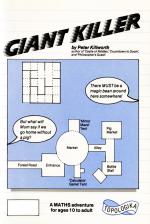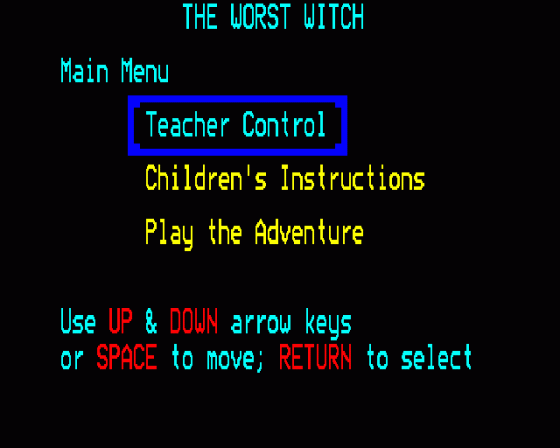
| Genre: | Adventure Game: Text-Only |
| Publisher: | Topologika |
| Cover Art Language: | English |
| Machine Compatibility: | Spectrum +3 |
| Release: | Professionally released on 3" Disc |
| Available For: | Amstrad CPC464, Archimedes A3000, BBC B/B+/Master 128 & Spectrum +3 |
| Original Release Date: | 22nd November 1987 |
| Original Release Price: | Unknown |
| Market Valuation: | £22.73 (How Is This Calculated?) |
| Item Weight: | 64g |
| Box Type: | Cassette Single Plastic Clear |
| Author(s): | Peter Killworth |
Variant Items
There are 0 other items featuring this same game (that we know about!). Click any of them for their details.
Active Auctions
Closed Auctions
Buy It
Unfortunately no-one is currently selling this item.
Auction Price Watch
Worried you're being ripped off? Closing prices on eBay can help you decide what a reasonable price is for a particular item.
Full Instructions
Giant Killer
About The Author...
Peter Killworth is the author of the best-selling adventure games Castle Of Riddles, Countdown To Doom, Philosopher's Quest and Return To Doom (all first published by Acornsoft and now available from Topologika), and the author of the book How To Write Adventure Games.
Giant Killer is his first mathematical adventure game for children. By profession he is an Oceanographer spasmodically commuting between his home in Oxford and the USA. He is married with two children.
About The Adventure...
Giant Killer is an exciting, flexible and challenging adventure game, very loosely based on the traditional tale of 'Jack and the Beanstalk'. It has been extensively tested with children and the adventure includes lots of mathematical and spacial problems for them to solve. Giant Killer has been written to the same exacting standards as Peter Killworth's highly-acclaimed adult adventure games, not least in the design of the maps and puzzles and the ease with which children and adults can use it.
As Jack - or Jackie - your task is to go to market to buy a pig. You'll be lucky to get one, of course, but if you can handle a calculator and map a maze - and if your Mum doesn't catch you first - you'll end up with a magic bean. Plant it and the rest of your adventure opens up. Will you explore the Giant's castle, try to cross the uncrossable canyon, or unlock that trapdoor in the back room? Puzzles gradually increase in difficulty covering investigations such as tesselations, prime numbers, Venn cubes, time and space, topology, logic...
Although Giant Killer is designed for children of 10+, adults will enjoy it too. You've read the book, now play this fascinating adventure game.
This Pack Includes...
Disc (with 'save game' feature)
Information Booklet
Maps and detailed solution
Worksheets
Player's Guide
Introduction
Giant Killer is based - loosely, and somewhat tongue-in-cheek - on the tale of Jack and the Beanstalk, though this doesn't mean that it's a game for children under five! It is squarely aimed at the 10-14 age group, although many older children - and plenty of adults - have already found the game charming, the puzzles challenging, and successful completion a rewarding and satisfying experience. In addition to providing children with an amusing diversion from 'ordinary' maths and the opportunity to participate in 'important' problem-solving activities, Giant Killer provides a framework for the teacher to organise his or her classroom teaching in original ways, or for the parent to enjoy some 'modern mathematics' with his or her offspring.
In Giant Killer, you take the role of Jack - or Jackie - and find yourself with the horribly boring but inescapable task of going to market to buy a pig - Mum's orders! Unfortunately, not even the groat she gives you can get you one - they've all been sold. So - being a Jack or a Jackie - you're faced with two alternatives: go home in disgrace, or give in to the temptations of the market stalls on which - with a bit of luck and some clear *mathematical* thinking - you'll be able to convert your groat into a penny, then a guinea, and finally into a *magic bean*. Your goals then are to *explore everywhere* and to find all the treasures; only by keeping them clearly in mind will you be able to attain the maximum score of 250 points.
All of the puzzles in Giant Killer are solidly based on mathematical activities. In the early stages of the game these are mostly tied to activities that children in this age group should have met: calculator work, simple spatial investigations, co-ordinates, and so on. As the player progresses through the game, the puzzles gradually become more complex and demanding: tesselations, topology, and - most important of all - mapwork, in addition to the intriguing time/space puzzles, in which you really do have to be in the right place at the right time.
The rest of this booklet provides: an introduction to 'adventure gaming' for those new to the experience; some ideas on using the program with children; and - unusually - *a complete worked solution* by author Peter Killworth. Also in the pack is a letter for children from Peter, a list of the commands that Giant Killer will accept, a map of the player's home village, and a set of work/activity sheets for teachers/parents to issue at their discretion.
Finally, a word of warning. Many children are notoriously good at this sort of game. Their excitement can literally sweep you off your feet. You'd be wise to get to know it well yourself, before you let them loose on it.
What Is An Adventure Game?
What is an adventure game? It's probably quicker to explain what it is *not*. Here you will find no aliens to *zap* with the touch of a key or a joystick; no mind-numbing repetitive music; no twelve-year-old wizard of the keyboard scoring a million without a sign of a brain cell. Instead, you can proceed at a pace that suits you; you can leave the keyboard for a cup of coffee and a long think. (And you may need it; adventure games are intelligent, and expect thought in return.)
Inside any adventure game you'll find a world created for your enjoyment. It may be a fantasy world; it may be closer to home, set in the pre-war houses of Greater London; or, as in Giant Killer, set partly in the Giant's castle at the top of a beanstalk. The world will have rules, just as the real world does. You won't know these rules, and finding out about them is one of the charms of playing an adventure game. You'll have a goal to achieve. This, too, can vary. In one game you might be trying to prove your rightful inheritance to a throne; in another, to regain your memory; or simply - as in a children's adventure like Giant Killer - to collect as much treasure as possible.
But achieving that goal will never be easy. Puzzles, varying from the easy to the mind-bending, will block your way. Sometimes you'll discover after a week that you hadn't solved a puzzle you thought you had - and feel that way again a week later! There will be other inhabitants of the world, most of whom will be there to hinder you. The computer will become a 'puppet', an extension of you. It will act as your eyes, hands and ears. But you'll rapidly stop seeing it as a puppet; *you* will react as if the events in the game happen to *you*. You'll say to yourself, "If I don't get out of here quick, that Giant mouse will take me for cheese.". It's this personal involvement that gives adventure games their special flavour...
When you buy a novel, the leading characters therein inhabit a world and have goals. An adventure game is somewhat like a novel - but rather an interactive novel. Have you ever bought a book and wished that the ending had been different? In an adventure game, you have the chance to modify what happens; within limits, you can explore where you will, and try out actions you would shirk from on real life...
You probably also don't buy novels to see a collection of illustrations. Nor will you find many illustrations in Giant Killer. Instead, children will find literate text, with descriptions that can conjure up images as strong as those in pictures. Maybe this is the way to get reluctant readers reading again...
So, how do you go about playing an adventure game? Let's suppose you've got Giant Killer running. Your goal is to explore everywhere and to collect as many treasures as you can find, so that you end up with the maximum number of points.
When the game has started you'll see something on the screen like this:
You are Jackie, a bold young lass. Your Mum has given you a groat to buy a pig at market.
You are standing in the garden of your house, the entrance of which lies northwest. The road is south; forest blocks the other exits.
:
The first thing that will strike you, if you've never played an adventure game before, is that nothing will happen unless you interact with the game by typing something. Reaction times are not important here. The ':' symbol is called a prompt. It tells you that the computer is waiting for you to tell it what you want to do. To talk to the program you don't need to know any special keys; the standard QWERTY keyboard will suffice. You must command the program to do something in reasonable, short English phrases.
What would be a sensible thing to do first? Since you're supposed to locate and collect all available treasure, it might seem sensible to have a look around your house. So how do you tell the computer that you want to do that?
Various possibilities come to mind: ENTER BUILDING, or ENTER HOUSE, or GO IN, WALK IN, ENTER or INSIDE. Some - not all - of these will work in Giant Killer. The computer may reply, "Eh?" (which means it didn't understand the first world you said) or "I don't understand that!" (which usually means it didn't understand the second word you said).
By and large, moving around is easiest if you simply give a direction (e.g. a compass direction like NORTH, or a 'standard' direction like UP or OUT) though many other versions and abbreviations are often understood. More to the point, why type ENTER HOUSE when just IN may do? (We've provided a list of most of the words that the computer understands in Giant Killer. More complicated adult adventures understand many more words and much more complex syntax.)
You won't find much of interest in the house. There's a trapdoor that's always puzzles you, because your mother never lets you down there. When you've finished exploring the house, why not have a look around the garden? The world of Giant Killer is waiting for you to explore it, and the nice thing about Giant Killer or any other adventure game is that more than one player can play it at a time; indeed, two minds may well be better than one.
We hope this short section has given you an idea of what adventure games are all about. The only *real* way to find out is to go exploring. Why not slip that disc into the drive right now?!
Children And Giant Killer
Although this section is mainly intended for teachers, parents may well find many of the following tips and ideas useful in tackling Giant Killer with their own children.
'Stretching' Individuals
Giant Killer is not intended just for more able children. It has been trialled with children of all abilities. Indeed, it has often been noticed that children who find 'ordinary' maths difficult are able to tackle such adventure games with gusto and delight, although they need help, of course, with many of the puzzles. It is therefore a particularly useful means of challenging all children.
Although, in our opinion, Giant Killer is best tackled by more than one child at a time, some teachers have achieved great success in motivating particular individuals who, for one reason or another, have been required to tackle the adventure on their own. The best strategy for this seems to be to literally throw them in at the deep end. They could be given the letter from Peter Killworth, the map of the village and the vocabulary list, be reminded of the original story and, finally, be told that Giant Killer follows this story only loosely but that, from time to time, they'll maybe discover what to do next by thinking back to the original story.
Peter Killworth's step-by-step notes (Section 4) give indications of where children are likely to come unstuck. Usually the fairy godperson can be relied upon to give some sort of meaningful assistance, but the child working on his or her own is likely to need - depending on ability, of course - a lot of support and back-up. We suggest that the work/activity sheets are issued to the child only if he/she is finding a puzzle particularly hard to solve or difficult to record.
How long should a child work at the program? Trials suggest that children can concentrate on it for great lengths of time, but somewhere between half an hour and an hour seems optimal. At this point the game can be saved (so that it can be returned to at a later date). Alternatively, the child can be told to 'take a break' when he/she comes up against a particularly difficult or time-consuming problem. Again, the game should be saved, and the child can then work at the problem back at his or her desk.
Many children enjoy keeping a diary of their work. ('This is what happened to me today...'). All should be encouraged to keep an accurate record of the puzzles they come across, and of their solutions.
Groupwork
We have found that the optimum size of group that can efficiently work on Giant Killer at a time is 2 or 3. The group should be expected to keep a diary of its 'goes' at Giant Killer. This could take the form of: a collection of textual descriptions of the scenarios; rough and, later, 'fair copies' of the territories explored; and, finally, clear descriptions of the puzzles encountered and the solutions found. This work can profitably be shared between the members of the group.
The strategy for getting the group going should be - again depending on ability - more or less the same as outlined above for using the program with a single child. The worksheets, maps, letter and vocabulary list can be freely copied for each child. Insist that they study this documentation before they start the program. The whole class can be shown how to get the program started and how to load and save games.
We strongly advise, however, that the worksheets are 'held back' from the group until they start floundering on a problem for which a sheet is available. We say this because we'd much rather children invented their own ways of tackling puzzles and recording their attempts. Much valuable learning can be got out of spending a few minutes with a group looking at the strategies they adopted and, if necessary, setting them on the right track and issuing the worksheets if they are hopelessly stuck.
Children using Giant Killer can be very persuasive. "Can we have a few more minutes, please?" We've found that it's best, from the outset, to give them a clear indication of how long they can have on the computer 'this go', and that it is best to tailor this to the member of the group whose concentration is least.
Giant Killer Versus The Class!
In this section we describe the way in which one teacher used Giant Killer with a class of around thirty children. He was lucky in that he was able to have the computer in his classroom for a period of several weeks. The program was introduced to the class as a whole. When they heard that they were going to play a maths game based on Jack and the Beanstalk there were hoots of laughter. These 11 year olds thought it was going to be a 'cinch'...
This introductory session consisted of: gettiing the class to, briefly, re-tell the story; showing them how to get the program started; showing them how to SAVE and how to move around the village; and splitting them up into groups. A rota was established, drawn up and displayed, together with a chart on which groups ticked off their 'goes' and recorded their scores.
Then, while the rest of the class got on with something else, the first group got started, the teacher by their side to lead them through their early moves. This wasn't really necessary, but it helped to established a sense of order at the machine. They kept having to restart through making 'daft' mistakes, so the class rapidly decided that each group's 'go' should be limited not just by time but also by number of restarts.
As the days progressed, a pleasant atmosphere of competitiveness was fostered in the classroom. In the early stages the teacher's role was simply that of organiser, enabler and encourager. With one group on the computer - and, even more so when he was able to get his hands on another computer - the classroom was a strangely quiet place, the group/s on the computer's operatiing in whispered secrecy, while the rest got on with their work, ears cocked for any hints that they might overhear.
Imaginative artwork blossomed, as children sketched in their diaries, got ideas, and expanded them into two-dimensional and three dimensional work of all kinds. Stories were written and, as the teacher came to appreciate the power of the program to simulate mathematical work away from the computer, he was able to introduce the class to topics that he might otherwise not have dared, and to topics that he knew would be coming up as the children progressed through the program.
After several days, with competitiveness - in some cases - getting a bit out of hand, and other classes clamouring to try the program, it was decided that the class would take a day off from the computer (while the other classes were introduced to it) and pool ideas. Diaries were compared, and fair copies made of maps, etc, showing locations of treasures and puzzles. It was decided that *solutions* to puzzles would not be displayed, but that if a group needed help with a particular puzzle they could go to another group for it. Any group requiring such help was to lose five points from their final score for each piece of help given; another column was added to the chart for this purpose.
And so the project went on, until most of the groups had successfully completed the program. Had time run out completely, the teacher had prepared for one final, all-out brainstorming session, with the whole class tackling puzzles at the same time.
Next time round, he says he'll tackle it a different way. Now that he knows the program inside out, he has a pretty good idea of the sticking points and knows what topics the project is likely to trigger off. He plans to base the whole of a term's maths teaching - short of basic number work and calculator practice - tackling the program with the class. Children will still work in groups, but they'll stop when they come to a particular puzzle, and the whole class will pitch its intelligence against this puzzle. He plans to have a whole series of worksheets ready to extend the children in the new areas that they'll come across in the program, so that while they're waiting for their next 'go' to come round, their daily maths will still be related to the Giant Killer work.
Maybe you'll devise other ways of using the program with children. We'd love to hear from you. Why not drop us a line at the address on the back of this booklet?
Program Guide And Hints
The purpose of this guide is threefold: to show you how to get the program started; to provide a worked solution for the whole game, including an optimal order; and to discuss each puzzle in detail, with a rationale. In some cases, suggestions for class work and/or extensions to the puzzles are given. In this way, some guidance is given for how many hints are necessary (though the 'fairy godperson' built into the game provides hints). Many of the puzzles are randomised; children should become aware that the solution which worked for their neighbours does not necessarily work for them. The game falls into natural sections (in addition to being scored as it proceeds), giving children a chance to compare their success rates verbally ("I've got past the chasm", etc). The description that follows is broken down into these clearly defined sections.
Getting Started
To get the game started, follow the instructions on the disc label. These are repeated on the separate leaflet entitled 'Technical Notes' supplied with this program. A loading screen will appear, then you will be asked whether you are a boy or a girl, and how loud you want the sound effects. (Note: Some versions may not provide sound facilities; refer to Technical Notes for information.) After this, the game will start.
The first message that you will see reads as follows:
To start from scratch, just press RETURN. To start from a SAVED position, swap discs if you need to, then type the name you need.
:
For the first few times you play, you would want to start from the beginning. To do this, just press RETURN. A short 'housekeeping' file, which keeps track of what you've done so far in the game, what objects are where, etc, is read from the disc. Obviously, if you're starting from scratch you haven't done anything yet; nonetheless the program still needs the file, which is called INIT and is on the game disc. Every time you start from the beginning, you'll need the game disc in the drive. So, if many groups will be using the program (From a single disc copy) we suggest that INIT be copied onto spare discs. (How to do this is in the Technical Notes.)
If you pressed the wrong key by accident (suppose you wanted to start from a saved game but pressed RETURN in error) then don't worry; just use the LOAD option mentioned in the vocabulary list.
Map 1: Ground level east of chasm, and market
Many children will not be used to the concept of mapping. While some of them will almost certainly be able to memorise the route as they discover it, a complete solution will be impossible without some actual mapping and a great deal of pencil and paperwork. Thus all children should be encouraged to draw a map (or maps) as they proceed.
Maps can usefully be a collection of boxes connected by arrows in up to eight horizontal directions - the number of vertical connections in the game has been deliberately minimised to aid the mapping process - or a written list of exits. (Copies of Map 1 are provided separately for issue to children. We hope that this will encourage them to construct similar maps for their own use.)

|
General comments: This area is fairly straightforward, with three puzzles and some stage-setting. The players should be encouraged to explore the whole area before setting off up the beanstalk, as it's important that they discover how to call for help, and there are objects they need later. However, they shouldn't be spending a lot of time at this stage trying to cross the chasm or open the trapdoor - they can't, yet.
Notes: The clearing (somewhat west of the start) contains a magic word to call for help at various stages. The word is (a) random and (b) non-functional until 'seen'; hence players must visit the area early on. Either 'SAY [word]' or just '[word]' will produce the required visit from the fairy godperson, where [word] means one of the three (random) possibilities ARRAZ, PUMLY and ROATH.
The market contains three puzzles (note that obtaining a pig is impossible). Each puzzle requires a specific entrance fee; the prizes for the first two are the fees for the next. The player is 'both' with the first entrance fee, a groat.
The first puzzle is directly mathematical: the computer chooses a number less than 100, and asks the child to find what number it must be multiplied by to make '100 point something'. This is a simple case of division with a calculator (hinted at on the screen). The player has three chances to get this right. The calculation is randomised on each entry to the area. The reason for the close connection with class work is to avoid losing the interest of the less able child, who will find the later puzzles quite thought-provoking.
The second puzzle involves a combination of mapping ability and understanding of analogue information. The player has to navigate a mirror maze of 5 x 5 rooms, beginning at the SE corner and exiting at the SW corner. The maze is partially randomised on entry. The players should be encouraged to think what the consequences of a large reflection in some direction might be, versus a small one. Where they can move is thus being presented in an analogue rather than a digital fashion: "You're in the mirror mage. Your reflection looks small to the north and easy, and large to the south and west." A mistake here isn't penalised heavily; the player simply gets another try (with a new maze). Mapping should be encouraged here; few children will be able to hold the maze in their heads.
The third puzzle is a mathematical 'investigation'. The player must place eighteen bottles into a 4 x 6 crate so that there is an even number of bottles in each row and column. The puzzle is handled visually, with co-ordinate input. Delete can be used after the first co-ordinate has been entered.
At the end of this sequence, the player possesses a magic bean. It should be obvious that this needs planting in the garden. For the next section, the game returns to traditional adventure concepts.
Optimal Route, Map 1
NB: The computer looks only at the first four letters of any word you type, so the command NORTHEAST must be typed in as NE to distinguish it from NORTH. If you just type TAKE instead of TAKE EGG, the commputer will reply 'Take what?' You must then say 'EGG' and not TAKE EGG, which would thoroughly confuse it!
S (to road)
W
W (road south of clearing)
GET CHEESE
N (clearing; find out magic word and test it)
GET SEED
S
E
E
E
E (entrance to market)
NE (market)
S ("Beat the calculator" tent)
E (answering calculator question; ends up in market)
N (mirror tent)
N (mirror maze)
See map 1 for possible routes through mirror maze; exact route depends on the random setting. Ends up in market once again.
E (alley)
S ("Bottle game" tent)
SW (entering the puzzle area; a suggested bottle layout is: 1,1; 2,1; 3,1; 4,1; 5,1; 6,1; 1,2; 2,2; 3,2; 4,2; 1,3; 2,3; 3,3; 5,3; 1,4; 2,4; 3,4; 6,4;
(Ends up in alley)
W (market)
SW (entrance)
W
W
N (garden)
PLANT BEAN
Maps 2 and 3: Early Giant's Castle Sequences
General Comments: The player has yet to achieve a score in the game! The first treasure can be collected here; all treasures are taken by the fairy godperson when the player picks them up, but the player's score goes up 10 points; thus children should be encouraged to check their score when this occurs.
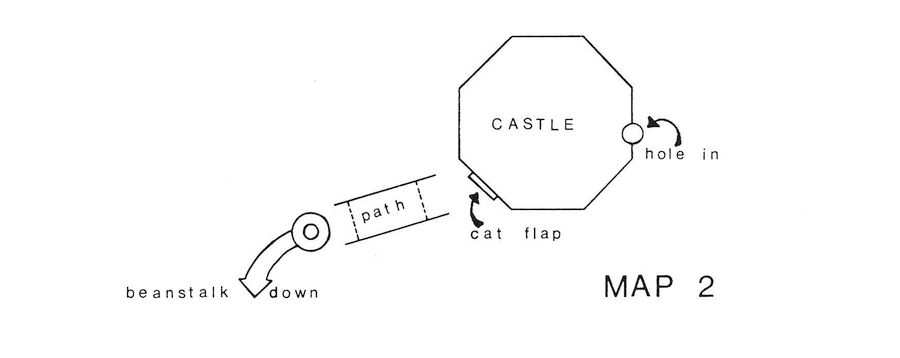
|

|
Notes: Climbing beanstalk, and exploring round the castle, is straightforward, and children should be encouraged to 'walk' right round it in order to discover its shape and a useful magic wand. The castle is octagonal. Discourage players from wasting time trying to enter the front door - they can't. Some children may deduce the function of the small door. There is an entrance hole to the east of the castle.
A giant mouse blocks the way into the castle. The fairy godperson will offer a hint; the solution is to throw the cheese in from the next room.
The way forward splits into two: on the west is a narrow corridor (also clued as a hidey-hole) which serves two distinct purposes. First, it provides the first half of the rules for a later puzzle ("Don't get down to 1 game"); children should be encouraged to note down the details, although they will probably be puzzled at this stage. Second, the narrowness of the corridor will make it impossible for the giant cat to enter in a few turns; players should read the room description carefully or they will miss this (crucial) fact.
Continuing northwest, the player enters an area containing the Giant's cat. If he/she is not to be caught by the cat and thrown out through the cat flap, the player must waste no time in beating a hasty retreat. This is the first of two similar puzzles devoted to the space/time concept, a somewhat grandiose name for the idea that the player should be in a specific place at a specific time! In this case, for the next few turns, the player must go back the way he/she came and dodge into the narrow corridor, which the cat can't get down. The cat will then attend to the mouse, and henceforth ignore the player. Although 'violent' vocabulary like 'kill' is not understood, ensure that players spend as little time as possible trying ways to remove the cat by violent means.
The way is now clear to acquire various useful items, and to climb up onto the Giant's 'game'. This game consists of an 8 x 8 draughtsboard, full of pieces except for a vacant square. The board - and the player's position - are shown visually when the player climbs onto it. Henceforth the player must keep track of his/her position the hard way. The player must occupy the vacant square at the end of each turn. The Giant announces its co-ordinates, which can only differ by up to one in the x (East) and y (North) directions, so that one of the eight horizontal directions will lead the player to the vacant square. Failure to do this will involve being thrown out; the player can't re-enter since the cat is in the way. (The rationale for this apparently punitive decision is because later puzzles in the castle are logically 'one visit only'. Thus although it would be useful to allow several attempts at the Giant's game, it would be illogical for the later puzzles. If players are having difficulty, remind them that saving before climbing the table leg - but after removing the cat - will ease the problem! Saving while in the game will throw the player out, since it takes a turn during which the player has not moved.)
The puzzle is concerned again with the transference of simple (x,y) co-ordinates into physical actions in space; also because whereas a child may be able to transfer *one* vector into an action, a continuous string of these can present problems. Hence, four in a row are offered. At the end of these, the player is trapped. The fairy godperson will provide a route out if help is sought with the magic word ARRAZ, PUMLY or ROATH. (Players should be reminded from time to time of the f.g.'s helping abilities.)
Optimal route, maps 2 and 3
U
U
U (top of beanstalk)
NE
NE (outside castle door)
N
NE
E (north of castle)
GET WAND
SE
S (east of castle)
D (hole)
THROW CHEESE (de-activating mouse)
NW (mouse lair)
NW (wide corridor)
GET TORCH (which is unlit so far)
W (hidey-hole; note down "Don't get down to 1" information for later)
GET CANDLESNUFFER (taken by fairy godperson, since it is treasure)
E (wide corridor)
NE (wider corridor)
NE (Giant's living room)
SW or B(ACK) (don't waste time or else the cat will catch you)
SW (wide corridor)
W (narrow corridor, losing cat)
E (wide corridor)
NE (wider corridor)
NE (living room)
GET SWORD
U (a simple graphics picture of the draughtsboard is given here - note that a press of the space bar is asked for here, in order to prevent the information scrolling off-screen)
Moves in several directions to vacant square. These are determined randomly within each session.
'Help' word to leave the draughtsboard when Giant stops moving pieces. (Note that the 'help' word has no effect while doing the puzzle, and use of it does not penalise the player, i.e. does not count as remaining stationary for a turn, which would cause ejection from the area.)
The player is then moved *magically* to the next area, the "Giant's inkwell".
Maps 4 and 5: Later Giant's Castle Sequences
General Comments: The puzzles are now beginning to involve more thinking than previously, apart from being less obviously 'school maths'. Ability to think spatially will be tested again; much pencil and paperwork, perhaps using the worksheets provided, will be necessary.

|
Notes: Once the player leaves the inkwell, she/he will be inside a set of carved, giant initials on a desk. No information on directions is given, so the player has to map out the initials (also randomised), and say them at the exit to leave. The initials are sensibly orientated with north up the page, and read 'AR', 'AH', or 'AK'. A treasure (a pen nib) is provided at the exit.
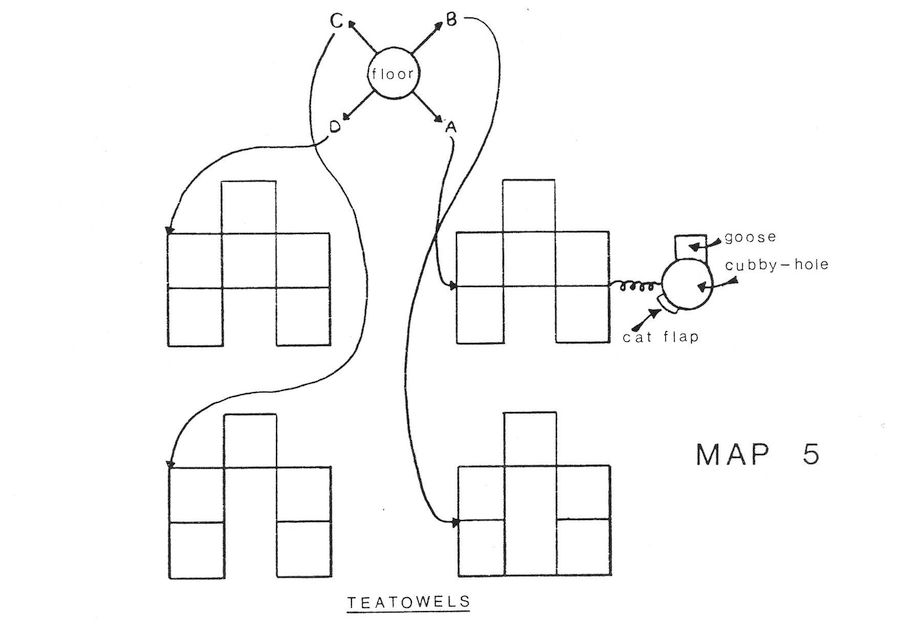
|
This moves the player to the beginning of quite a tricky puzzle - the Giant's tea towels. A key (which will unlock the trapdoor in Jack/Jackie's house at the beginning of the game) is found here. Four exits are provided, each leading via a jump to a distinct, motheaten tea-towel spread horizontally above a toaster to dry. The player should make a SAVE before trying any of the exits, and experiment to discover the 'ground rules'. These are: each move orthogonally along a tea-tower strand (north/south/east/west) clicks the toaster down by 1, and deletes the strand just used. If the player arrives at a junction with no strands, he/she falls into the toaster. There are fatal results unless the toaster has turned off (a reading of zero).
These rules are equivalent to an Euler (or traversible circuit of a network without going over a line twice. Four networks have been devised for the players to try out, all with fourteen nodes. That to the NE is totally non-traversible (6 nodes with odd vertices). That to the north-west merely has four odd nodes, but remains non-traversible. To the south-west, the circuit is traversible (two odd nodes), but the player arrives at the wrong node to begin with (an even node). To the southeast, the circuit is identical, but the player now arrives at an odd node, and the problem can be solved. There is a great deal of opportunity for map-drawing, class discussions, predictions of where the route must end, etc, as well as obviously related lessons on traversible circuits. Map 5 shows the four tea-towels; the relevant circuit can be found by inspection.
Assuming the poor player survives, he/she finds a cage with a goose which lays prime golden eggs. The pun *is* intentional; after the player has dealt with the Giant (see below), there is a 3/4 chance that the carried goose will lay a (numbered) egg, which will vanish one turn later if left unattended. All non-prime eggs are fatal! If an egg is laid, the chances are just over 42% that the egg will be prime.
Leaving the castle with the goose (through the catflap) triggers a chase, the second time/space problem. The player must retreat down the beanstalk, and cut it down immediately on reaching the bottom with his/her sword, the only violent game action. Any dalliance from this is fatal; there is no obvious game-sensible way of avoiding this, but the castle needs to be 'turned off' to concentrate the player's attention elsewhere.
Optimal Route: Maps 4 and 5
Player begins at inkwall.
E (into carved initials)
NE (beginning exploration)
Further exploration and mapping, arriving at exit.
GET NIB
AR/AH/AK or SAY AR, etc.) Player is transported to the floor.
GET KEY
SE (to tea-towel)
(There now follows one of many routes which will work)
N
E
S
W
S
E
N
E
S
E
N
W
N
W
N
E
S
E
S (falling safely off tea-towel to cubbyhole)
GET GOOSE
OUT (causing Giant to wake up; player now SW of castle)
SW (forced move)
SW (ditto; player now at beanstalk)
D
D
D
CUT BEANSTALK (removing problem of Giant permanently)
WAIT (or move around)
Player must wait until goose lays a prime-numbered egg, and then immediately pick it up to score the points for it. The goose will then stop laying.
Map 6: West Of Chasm Sequence
General Comments: It is now possible for the player to unlock the trapdoor and investigate underground. However, she/he should be discouraged from this because the entire area is pitch dark, and the torch has yet to be lit. The player should be steered towards the chasm, which can now be solved. The placement of the wand, near the castle, ensures that players can, if they prefer, retreat down the beanstalk and investigate the chasm prior to solving all the castle sequences.
The canyon area contains two non-mathematical puzzles (for relaxation) and one fairly hard puzzle relating to Pythagoras. Players should be encouraged to draw a fairly accurate sketch map of the area, although a graphics picture is provided as part of the text, together with a fairly precise text description.

|
Notes: The player should now possess the wand, which is a 'standard' bridge-builder. Waving or rubbing it on the east side of the chasm will fly the player to the other side (once only), albeit in an unusual fashion - the player is carried by a large gerfalcon (bird) which deposits the player west of the chasm. A treasure (a silver gauntlet) is here to add to the score. The only route leads westwards, where the second half of the rules for the "Don't get down to 1" game are met, together with a matchbox, used for lighting the torch. (Please suggest that players do not immediately return to the east side of the chasm, but solve the Pythagoras puzzle first.)
Once in the canyon, the main problem is to reach a square island, which unable to swim. The player can access two sides of a square lake (south and west), and can use a plank and a log as tools. Neither will quite reach to the island, and verbs like TIE are not understood! The method involves laying one of the two long tools diagonally across the SW corner of the lake, moving onto it, and laying the other NE to the island. Although obviously the problem can't be randomised, players should have to think fairly carefully, and much class discussion should be possible. In the graphics picture, the distances are approximately correct. Neither plank nor log can be re-accessed once in position. On the island is a treasure (a ruby elephant).
To return to the east side, the player must drop or throw the birdseed where the gerifalcon can see it.
Optimal Route: Map 6
(Player moves to east of chasm on foot)
WAVE WAND (transport player to west side of chasm)
GET GAUNTLET
W (note "Don't get down to 1" information)
GET MATCHES
LIGHT TORCH (may as well do it now; it doesn't run out)
N (east end of beach)
W (along beach)
GET PLANK
W (along beach)
DROP PLANK (diagonally across between beaches)
NW (onto plank)
NW (onto northward beach)
N (along beach)
GET LOG
BACK
SE (onto plank)
DROP LOG (making route NE to island)
NE (onto log)
NE (to island)
GET ELEPHANT
SW
SW
SE (dry land)
E
E
S
E (west side of chasm again)
DROP BIRDSEED (free ride to east of chasm)
E
E
E
N (into garden)
IN (into house)
Map 7: Under The Farm Sequence
General Comments: The problems now become somewhat trickier, and mainly spatial in concept. There is almost none of the 'standard adventure' pill-sweetening, and the player is presented with a continuous puzzle collection. Slower children may well need some help during these sequences, although the nature of the puzzles means that a good deal of experimentation is possible, especially with the 'workmen' and 'Venn Cube' problems.
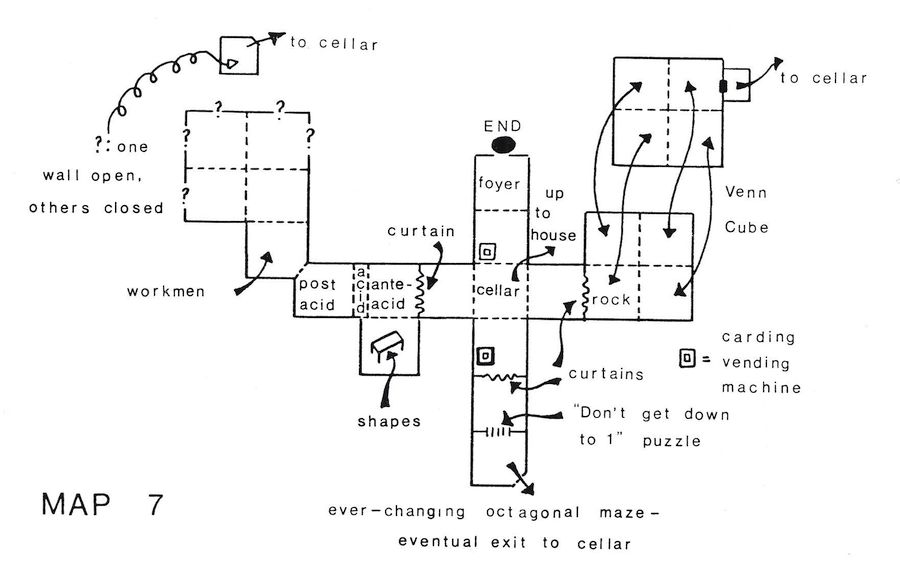
|
Notes: To get underground, unlock/open the trapdoor with the key. The underground rooms are not lit, so that the torch will have to be lit (with matches). This isn't intended as a puzzle, though some players may find it so; it's merely designed to steer the players in a sensible, sequential structure. In theory, there's no reason why players couldn't wander round in the dark, though they would find finishing the game well-nigh impossible.
The player will find a crossroads under the house, and a doubloon (treasure). To the north, progress is barred until all other puzzles have been done. To the east, south and west are curtains, each with a slot for a playing card. Only when a card of the appropriate colour has been inserted can that curtain be passed; and it cannot be passed again later (to avoid resetting problems). Two curtains require red cards, one a black card. Supplies of these cards can be found in two machines, fed by tokens. The cards available are visible to the player, and one only is obtainable per token (of which only one exists initially). The difficulty is that the only sequences you can get out of the machines are: red, black, black, ... and black, black, red, ...
Even given that a token is found through each curtain, some pencil and paperwork should convince the player this is the case. (This puzzle is a special case of a more general problem, and children should be encouraged to think how sequences could be derived to limit choice to any set of two binary choices.) The solution to the apparent impasse, found through playing, is that a spare red card is to be found through the south exit! Many children do not notice the potential card problem. Some verbal cues may well set them thinking!
A red card will take the player west. His/her path is now blocked by a pool of acid, the centre of which needs covering (tesselating) with acid-proof polygons so that the player may stand on it en route. Unlimited sets of triangles, squares, pentagons, hexagons, octagons, and decagons are provided. Various rules applied in the game ensure that only the use of one type, repeated, can succeed in tesselating a central area. Triangles, squares or hexagons will succeed; the others fail (this ignores the Cairo pentagon tesselation). The player is expected to work out how many are needed to tesselate, or meet in the centre and cover 360 degrees (6 triangles, 4 squares, or 3 hexagons). No penalty is given for over-tesselation, so that the puzzle is benign, and the player is informed when it is safe to cross.
Beyond the acid lies another treasure (a fossil) and a randomly chosen first letter of a password. This, too, must be noted down for later use. This area is followed by the 'workmen' spatial puzzle. A square of 2 x 2 rooms is entered at the southeast corner, accompanied by workmen clutching five partitions. The area thus resembles:

|
The player only receives a verbal description. There is a single exit (other than where the player entered) whose location is determined randomly on entry. Thus the dotted exits in the diagram are open, and those with question marks are all closed except one random exit. The player must stay inside the area for five turns; at each turn erecting a partition in one of the (possibly four) un-partitioned or un-walled directions about him. Only then is he/she permitted to leave, on turn 5, assuming she/he isn't blocked in by then (when the player is thrown out for another try). It is instructive to seek a guaranteed strategy before reading the solution below.
The solution is believed to be unique, apart from a reflection about the southeast-northwest axis. On turn 1, block up the entrance behind the player; wait a move, and block the northwind direction. (Children may well not think of waiting in place as an option, so this can be suggested.) On turn 3, move west and block the east direction (from which the player has just come), thus completely sealing off the entrance room. If the exit is now visible, move north and block the east direction, return south and block the northward direction, then leave; if the exit is not visible, move north and block the south direction and then determine the optimal room to finish in depending on whether the exit is visible or not. This puzzle should create a greal deal of class discussion, especially if some children find a lucky arrangement on the (possibly only) time they enter.
Beyond this puzzle lies a spare token, a treasure (a geranium) and a passage back to the crossroads. Obtain a black card, insert it in the slot, and go south.
Here the "Don't get down to 1" game appears, whose rules were provided earlier. Incorrect answers are not penalised; the player just tries again. The puzzle involves the well-known series wherein each subsequent number is computed from its predecessor: half of it if the predecessor is even; 3 times it plus one, if odd. As far as is known, all such series eventually reduce to a cyclic '4, 2, 1, 4, ...' pattern. The child must name a number for which this does not occur; the solution involves the fact that the series beginning with 27 is inordinately long! Players should try out various values on calculators (or with paper) to get a feel for the series; there would be an opportunity for some class work here too.
Beyond here lie a treasure (a cameo), information on the middle better of the password, and an entry to an ever-changing maze. It consists of eight rooms, all made of different materials, each with eight horizontal exits, one of which leads to each of the eight rooms (i.e. including the room the player is already in). The sequence is randomised on entry. Lurking therein is the spare red card and a treasure (a swan). One exit, again random, leads out of the maze with a warning about finding the two objects in case the player missed them.
The point of the maze is that mapping, as a spatial exercise, will almost certainly fail here. A tabular approach is required, which may be new to many players. A suggested layout might be:

|
Each exit will have to be tried until the two objects and the exit are found. Beyond here, the player can return to the crossroads.
The final direction is easy, into the Venn Cube. This consists of eight rooms in a 2 x 2 x 2 cube. Each room has three binary properties (red/black, rough/smooth, large/small) and the orientation is such that moving east or west changes one property, north or south another, and up or down the third. There is an exit at the opposite corner to the entrance to the cube. In the entrance room lies a rock. It, too, possesses the same three binary properties. Left to itself in the entrance room, it 'counts' in binary (a point which could be discussed with children), changing its properties every turn of the game (with the player being informed of this as it occurs). Thus, after eight turns, it eill have returned to its initial scale. If the rock is held, or left in another room, it remains unchaging. However, if it is held as the player passes from one room to another, the rock changes the same binary property as the rooms changed, although it may be out of phase with the rooms by this time. In other words, moving with the rock from a rough to a smooth room will change the rough/smooth property of the rock to its opposite; the player will again be informed.
To exit, the rock must be held and have a randomly chosen (on initialisation) set of three properties, which are announced to the player. This should provide opportunity for much experimentation and discovery that no matter how one moves around the cute, the properties of the rock in the exit room remain fixed. The player must then discover how the 'set' properties of the rock when it is picked up relate to those in the exit room (they are all opposite). Thus the solution involves finding the required rock properties, returning to the original room and leaving the rock until it acquires the opposite to the desired properties. Then pick it up and return to the exit.
Exit from the puzzle provides the last letter of the password, plus the expected treasure (a diadem) and a token.
The player can now enter the treasure vault. Correctly quoting the password will allow the game to be won, hopefully with 250 points if all treasures have been picked up (including the prime egg).
Optimal Route: Map 7
(Assuming player in house)
OPEN TRAPDOOR
DOWN (cellar)
GET DOUBLOON
E (gritty cellar)
GET TOKEN
B
N (grotty cellar)
INSERT TOKEN (getting King)
S
W (dingy cellar)
INSERT KING
W (ante-acid room)
*S (chamber with shapes)
*GET HEXAGON
*N
*THROW HEXAGON
(Repeat these *ed actions three times)
W (post-acid room) Note first letter of password
GET FOSSIL
NW (wooden room/workmen) Through partitions maze to sky blue chamber
GET TOKEN
GET GERANIUM
NW (to cellar)
S
INSERT TOKEN (getting a five)
INSERT 5
S (round black chamber)
S (answer "Don't get down to 1" question with 27)
To cramped plastic box. Note middle letter of password.
GET CAMEO
SE (into octagonal maze) Find/take swan & Jack & exit to silken room
NE (cellar)
E (gritty cellar)
INSERT JACK
E (Venn cube)
N
U
E
E (this will fail; discover rock type necessary)
W
D
S (rock room)
WAIT (as necessary, until rock is opposite of that required)
GET ROCK
N
U
E
E (dusty cupboard) Last letter of password; no need to obtain token
GET DIADEM
NE (cellar)
N
N
SAY [PASSWORD] to win game.
Location Of Objects
| Player | Garden |
| Cheese | Road south of clearing |
| Birdseed | Clearing |
| Trapdoor | House |
| Groat | Player's hands |
| Penny | To be won |
| Guinea | To be won |
| Cage | Cubbyhole inside Giant's front door |
| Goose | Cubbyhole inside Giant's front door |
| Bean | To be won |
| Wand | North of castle |
| Mouse | Mouse lair |
| Toothpick/torch | Wide corridor |
| Cat | Living room |
| Tiepin/sword | Living room |
| Key | Floor after initials |
| Gerfalcon | West of chasm |
| Matchbox | Canyon |
| Plank | South of lake |
| Log | West of lake |
| Table | Chamber south of ante-acid area |
| Machines | North and South of cellar |
| King, Queen, 3, 5, 9, 2, 8, 4 | In machines |
| Jack | Hidden in octagonal maze |
| Rock | In first room of Venn cube |
| Triangle | On table in chamber |
| Square | On table in chamber |
| Pentagon | On table in chamber |
| Hexagon | On table in chamber |
| Octagon | On table in chamber |
| Decagon | On table in chamber |
| Workmen | Pre-partition (wooden) room |
| Token | East of cellar |
Location of all Treasures
| Candlesnuffer | Narrow corridor/hidey-hole |
| Nib | Exit of initials |
| Egg | To be laid by goose |
| Gauntlet | West of chasm |
| Elephant | Island |
| Doubloon | Cellar |
| Swan | Hidden in octagonal maze |
| Geranium | Beyond partitions |
| Diadem | Beyond Venn Cube |
| Cameo | Beyond "Don't get down to 1" game |
| Fossil | Post-acid room |
Player's Guide
Giant Killer is an adventure game loosely based on the famous old story of Jack And The Beanstalk. If you're young enough to remember that story, you'll know that it gets off to a pretty *boring* start, with your mum sending you to market to buy a pig.
Once you've discovered that this is an impossible task anyway (the market runs out of pigs *very* quickly), I suggest that you go exploring. There are lots of treasures to find, and it's much more fun than going home and telling Mum what a waste of space you are...
What you have to do in Giantkiller is to find all the treasures and explore *everywhere*. The computer will be your eyes and hands. It will tell you where you are and what is happening around you - and you must tell it what you want to do.
You do this by typing in commands. The computer will ask for these with a colon (:), then wait for you to 'say' something. You can use commands of one or two words (no more!) in UPPER or lower case, such as TAKE EGG or tHrOw WaNd. (Don't forget to press RETURN after you have typed in a commmand.)
I've given you a list of most of the words the computer understands. There are some magic ones too - but I'm not going to tell you them! I'll leave your fairy godperson to do that... Obviously the computer won't understand everything you say; computers aren't that clever (yet). "Eh?" means it didn't understand the first word you said. "I don't understand that!" usually means it didn't understand your second word.
One clue I will give you is that passages sometimes bend. For example, you might go WEST and end up in, say, a mysterious canyon, and then, when you try to go back EAST you might not get back to where you started from! If this happens you'll probably find it annoying at first - but it's all part of any good adventure. The secret is to draw maps...
It is possible to 'die' in the game, but not very often. Usually you just get another go at whatever puzzle you were attempting, or you have to re-start from the beginning. Many of the puzzles have different answers each time you play - so what worked for your friends probably won't work for you! Sneaky!
If you suspect that your next move or answer to a puzzle may be a bad one, it's best to SAVE your position. Simply type SAVE and press RETURN. The computer will ask you for a filename which can be up to seven letters or numbers long. Make sure that the names that you use for the files are different to those of anyone else who might play the game. You can easily restart from that SAVEd position. Just type LOAD, or stop the current game and restart using your selected filename.
One word of warning. Saving is *not* a good idea in the middle of something dangerous, because it takes a 'move' in the game. If, say, the giant is chasing you (and you need to keep moving), then SAVEing will kill you because the computer thinks you stayed still during that move! So SAVE *before* doing anything dangerous, not while it's happening!
If you can't remember the name you gave to a file, type CAT (short for CATALOGUE) and the computer will show you the names of all the files on the disc. Of course your files may not be the only names on the disc. Your friends may have files stored on it too, and the prorgams are there, of course...
Well, I think that's about all I'm going to tell you. I really enjoyed writing Giant Killer, and I hope you enjoy playing it - and maybe learn some maths!
Oh, I'd better just tell you the eleven treasures you're seeking:
- a jeweled candlesnuffer
- a platinum nib
- a golden egg
- a silver gauntlet
- a ruby elephant
- a valuable doubloon
- a mica swan
- an everlasting geranium
- a diadem
- an ivory cameo
- a fossil in amber
The best score anybody can achieve in Giant Killer is 250 points. Just type SCORE to find out how you're doing.
Good luck! Why not write and tell me how you get on, and what you think Giant Killer?
Peter Killworth
Author, Giant Killer
Finally
Here is a list of the main words the computer understands. In addition to these it will recognise the names of all the objects and treasures that you come across.
B or BACK or RETURN - moves you back to where you came from
CAT - tells you what files are on your disc
CHOP or CUT
CLIMB or U or UP - moves you up (quicker to type than 'go up')
CLOSE or LOCK
D or DOWN
DROP
E or EAST
ENTER or IN - go into some place or something
EXIT or OUT or LEAVE
GET or TAKE
GO or MOVE
HELP
INSERT
INV - short for 'inventory' - gives a list of all your possessions
LOAD - restarts your game from a previously saved position
LIGHT
LOOK - jogs your memory about what's around you
N or NORTH
NE
NW
OPEN or UNLOCK
PLANT
QUIT or STOP - ends game and/or lets you play again
RUB
S or SOUTH
SAVE - takes a copy, on disc, of where you got to
SAY
SCORE - tells you how you're doing (maximum 250)
SE
STRIKE
SW
SWIM
THROW
W or WEST
WAIT - do nothing for a turn
WAVE
Notice that words like 'attack', 'kill' etc are not in the vocabulary. Giant Killer is a fairly gentle game!


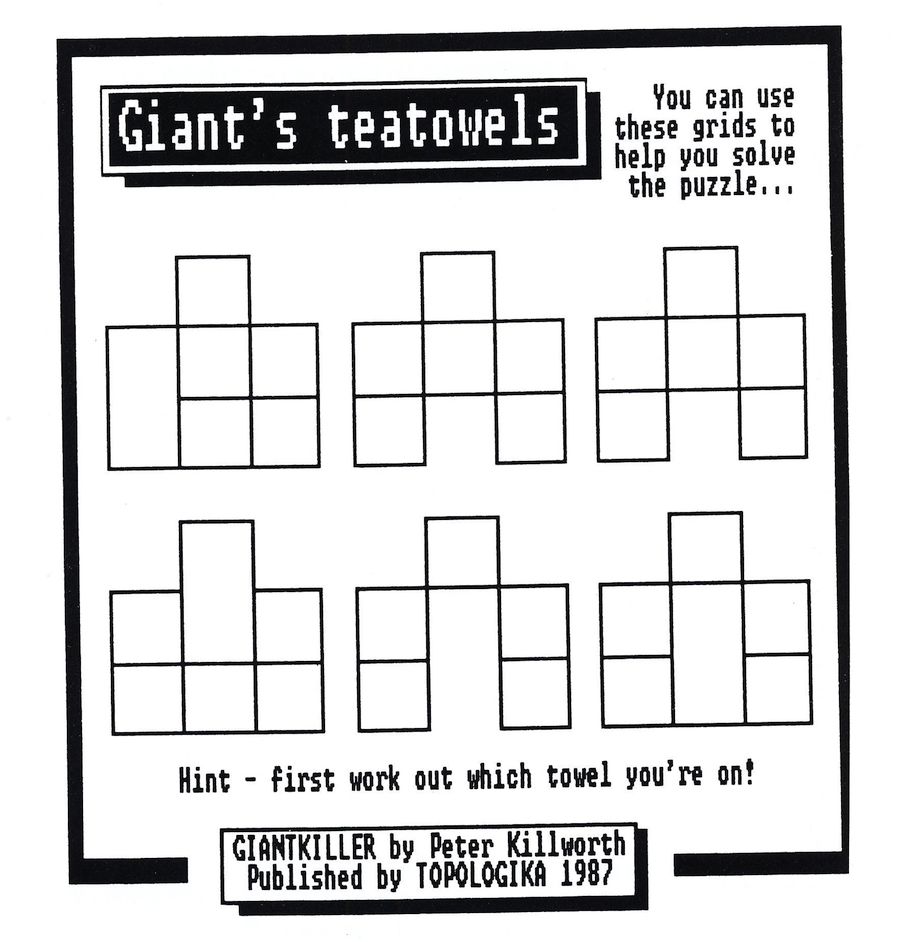

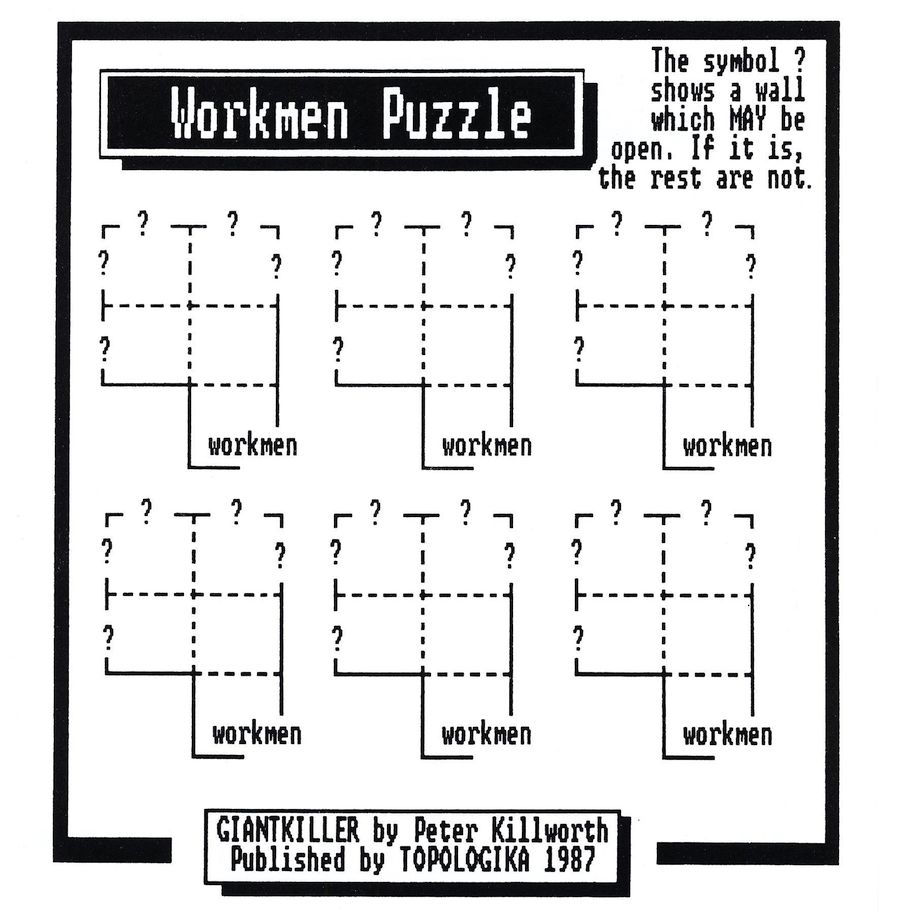
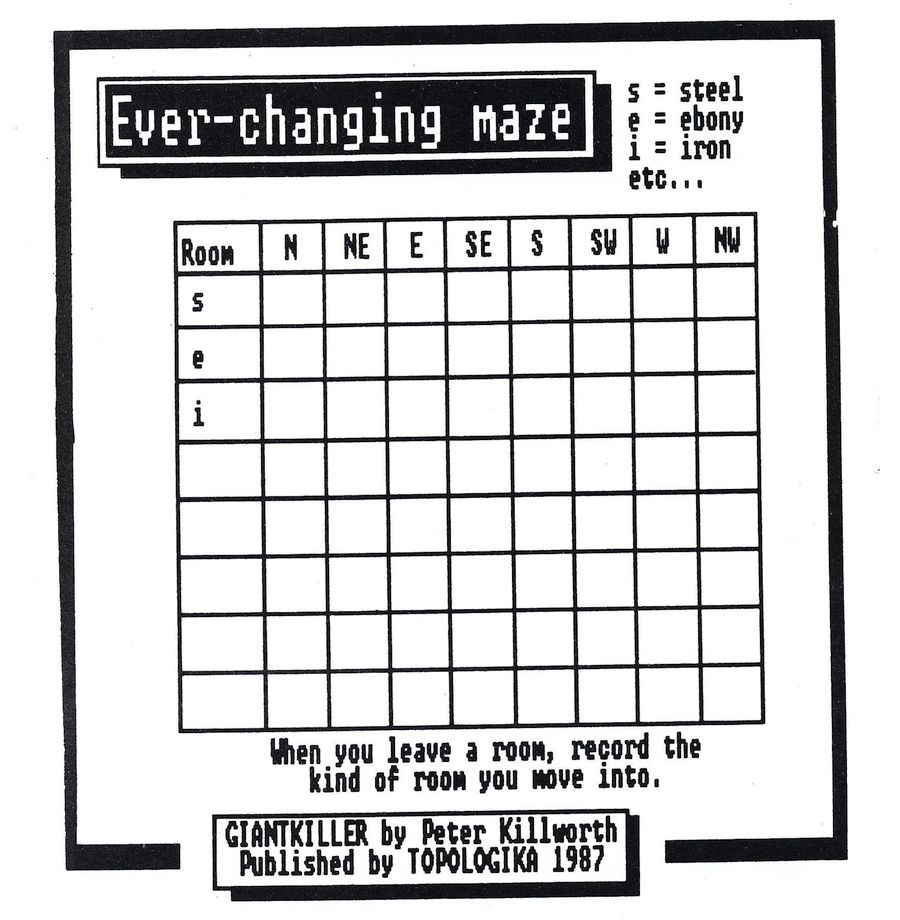

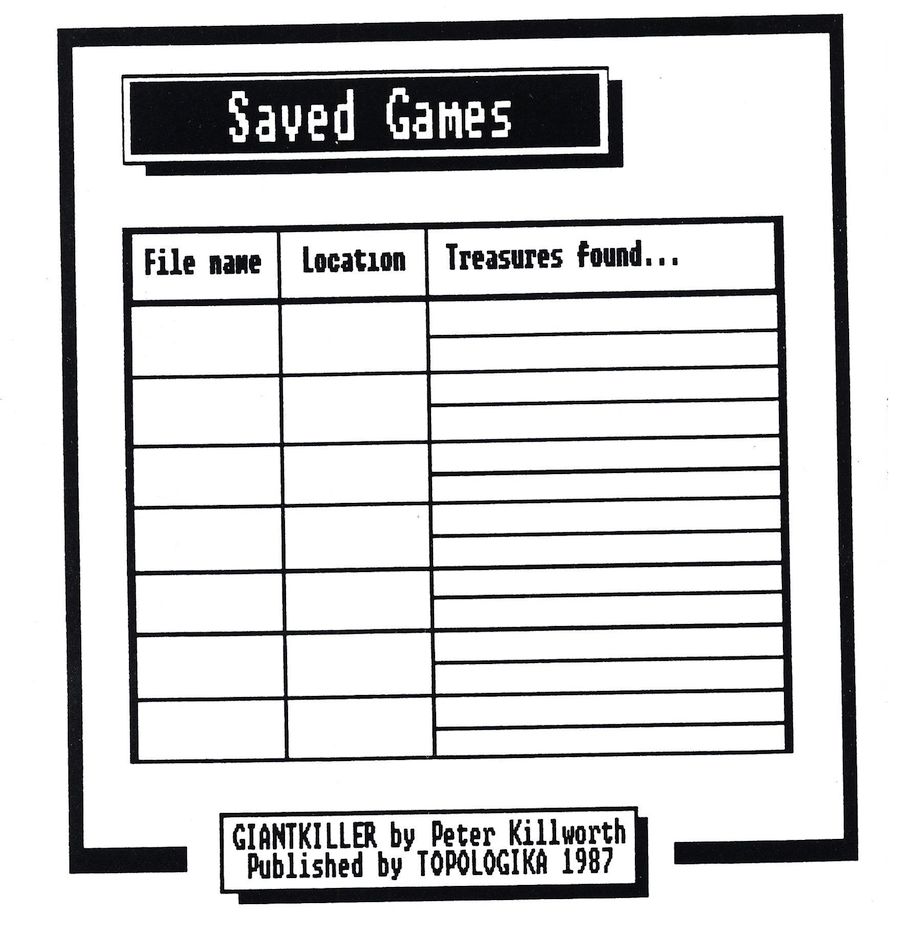
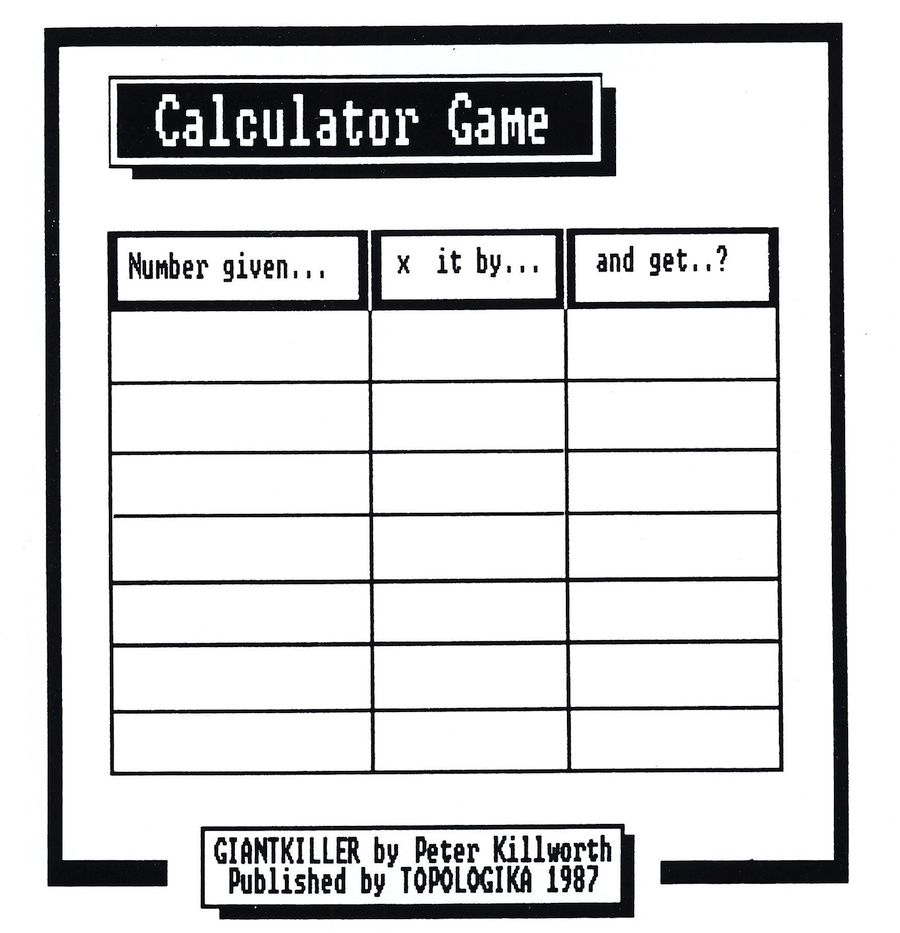
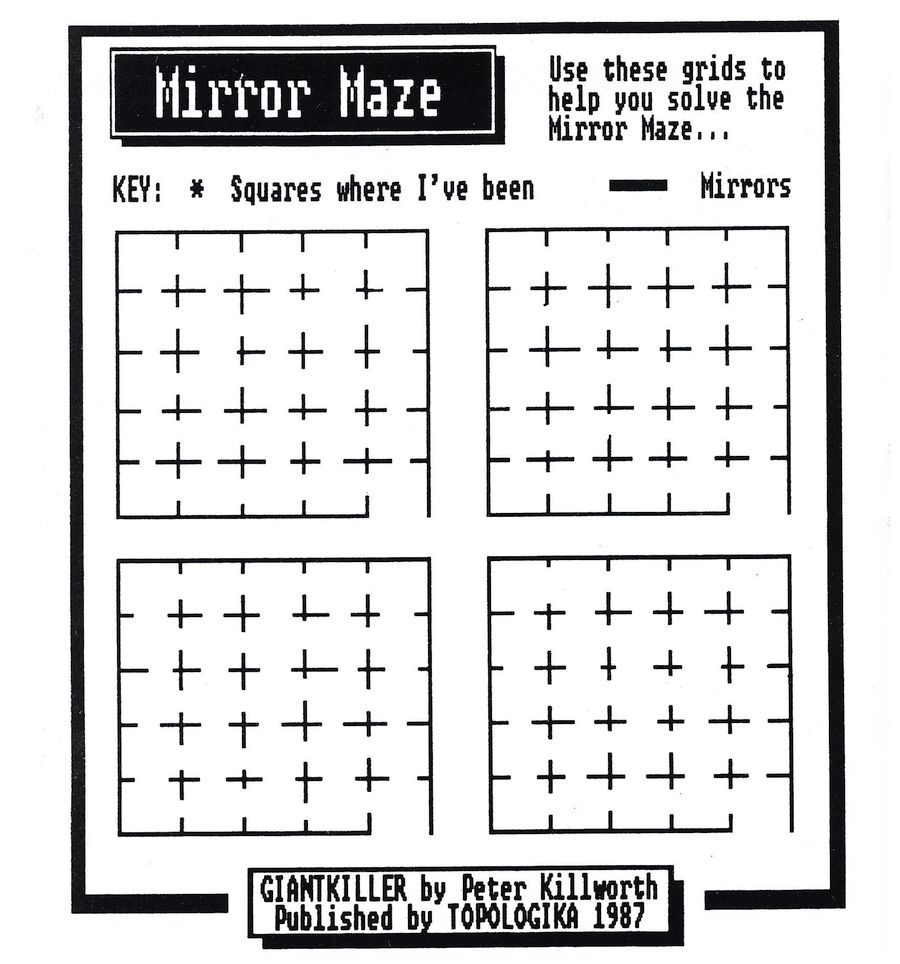
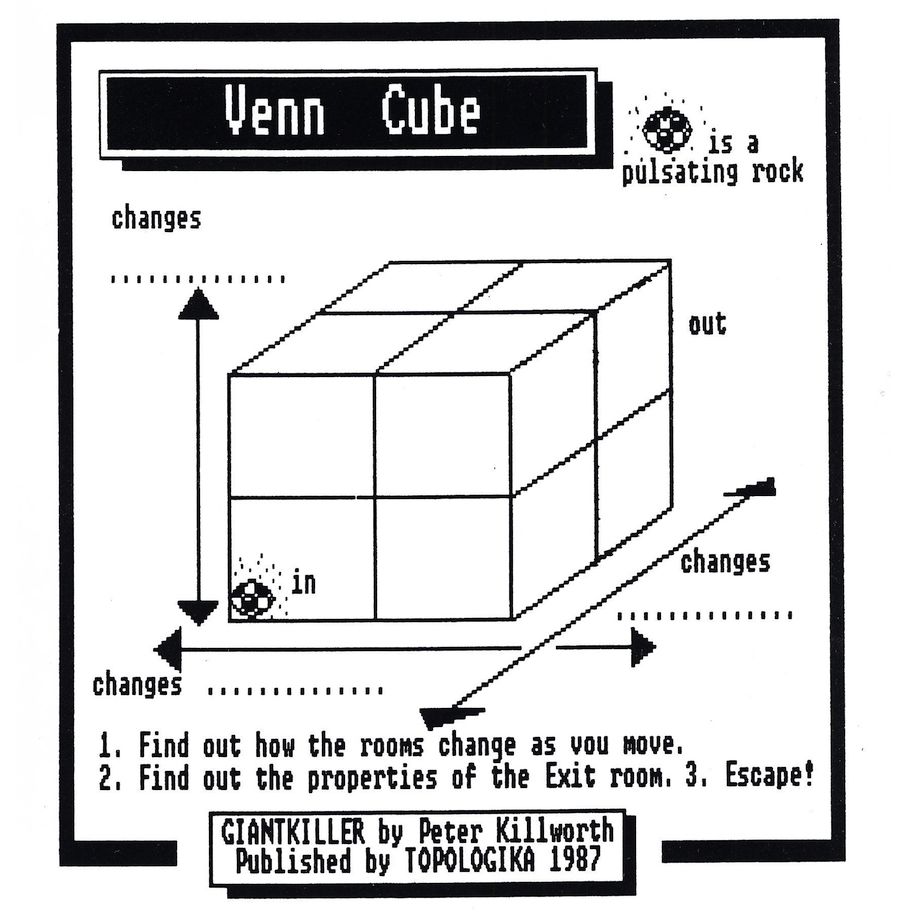
|
Screen Designers
The following utilities are also available to allow you to edit the supplied screens of this game:
Cheats
Download
A digital version of this item can be downloaded right here at Everygamegoing (All our downloads are in .zip format).
| Download | What It Contains |
|---|---|
| 3" Disc | A digital version of Giant Killer |
Games Like Giant Killer
Report A Problem
We thank you from the bottom of our hearts if you report something wrong on our site. It's the only way we can fix any problems!
You are not currently logged in so your report will be anonymous.
Add Note
Release Country
Change the country to update it. Click outside of this pop-up to cancel.
Scan Of Selected Article
If you auction an item, it will no longer show in the regular shop section of the site.

